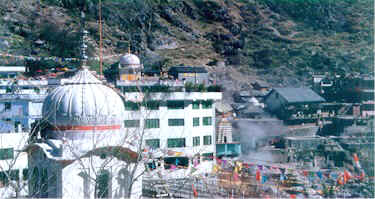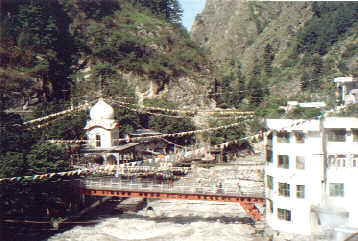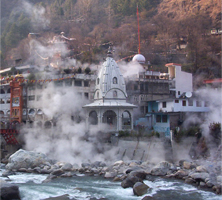
Location: Parvati Valley near Kullu-Manali
Altitude: 1,737m
Houses: Ramchandra temple & Sri Guru Nanak Dev Ji Gurudwara
Famous For: Hot Springs
Famous
As a: Hindu & Sikh Pilgrimage
High
up under the snowy peaks, of the Parvati Valley is situated
the hot springs at Manikaran. The water from the steaming
springs is noted for its healing properties. The springs
in the area are hot enough to boil rice in it. Manikaran,
a place of pilgrimage for Hindus and Sikhs, has a temple
and a gurudwara. It is also a good spot for trout fishing.
Sri Ramchandra temple is located in the center of the
town and one can have a very good look in and around
this temple. The Sri Guru Nanak Dev Ji Gurudwara provides
some extraordinary sights. One can enjoy a dip in the
hot waters from the springs. There are altogether three
baths, one is located under the Gurudwara itself and
the other two are privately owned and located in guesthouses.
THE LEGEND OF MANIKARAN
While wandering of in the forests of the Himalayan
ranges Lord Shiva and Goddess Parvati came across a
place now called Manikaran. The mountain-locked area,
the lush green patches and the forests charmed them
and they decided to stay there for sometime.
For as long as eleven hundred years they remained at
this place. At one time, when the Lord was relaxing
with the Goddess, in the beautiful waters of a stream
running by the side, the 'MANI' (Jewel) in an earring
of the goddess dropped somewhere.
Parvati was much distressed and there was a thorough
search but efforts to find out the jewel failed. Lastly,
the Lord ordered his attendants, to trace out the jewel,
wherever it may be. That was also unsuccessful. Lord
Shiva got enraged, as a result of which his third eye
opened. With the opening of the third eye of the Lord
Shiva, a very ominous event, there was a great commotionall
over the universe. The entire universe was very upset
and apprehended a great calamity.
'Shesh Nag', the serpent god, was
approached. In order to subside the anger of Lord Shiva,
Shesh Nag hissed and hissed and there was a flow of
boiling water, which passed over the area and out came
a number of precious stones of the type which were lost.
Lord Shiva was pacified. The water still continues to
be hot. Before the earthquake of 1905, which affected
this area also, it is said, that this boiling water
used to rise, to about ten-feet high.
 The
visiting deities are given a ceremonial bath. The second
chapter of 'Brahm Puran' recites the story of Manikaran
as given above. The place is described as one of hot
and cold waters and the divine pair had repaired there
for water sports known as 'Jal-Krida'. Fragrant and
attractive flowers graced the place and by a bath at
the 'Sangam' one is eternally blessed. The Brahm-Puran
enjoins the pilgrims pass a night awake at Manikaran
and do puja or 'Raat-Jagran'. The
visiting deities are given a ceremonial bath. The second
chapter of 'Brahm Puran' recites the story of Manikaran
as given above. The place is described as one of hot
and cold waters and the divine pair had repaired there
for water sports known as 'Jal-Krida'. Fragrant and
attractive flowers graced the place and by a bath at
the 'Sangam' one is eternally blessed. The Brahm-Puran
enjoins the pilgrims pass a night awake at Manikaran
and do puja or 'Raat-Jagran'.
Thereby the pilgrims obtain the full virtue of the
world. The story of the loss of the jewel and the frantic
search and ultimate recovery is vividly described. The
tract is Lord Shiva's own and a pilgrimage at this place
is adequate and one need not visit Kashi and other places
of pilgrimage.
Lord Ramchandra Temple: There are
several temples in the Mani Karan village. The most
important is that of Lord Ramchandra. The Pandas or
priests of the village claim that the idol of Rama was
brought from Ayodhya and installed in this temple by
the Raja of Kulu but this lacks a historic confirmation.
There was also an idol of Lakshman the younger brother
of Lord Rama Chandra, which has now disappeared. On
the left hand side of the Lord is the idol of Goddess
Sita. The temple is very old and on one of the stones
in its wall, the history of the temple is written which
is not legible.
Temple of Lord Shiva: There is another
very old temple of Lord Shiva, which got tilted during
the earthquake of 1905. The great prestige with which
Manikaran is held is seen by the fact that the Devatas
of Kulu valley pay regular visits to Manikaran. The
followers of the individual deities at different places
are carried ceremoniously in a procession to Manikaran
on specified auspicious days.
 Sri
Guru Nanak Dev Ji Gurudwara: The place is also
held sacred by the Sikhs. The Janam Sakhi or the 'Twarikh
Guru Khalsa' by Giani Gian Singh mentions about the
visit of Guru Nanak Dev to this place. It has been mentioned
that accompanied by his disciple Bhai Mardana, the Guru
reached Jwalamukhi temple after visiting Kalanaur, Gurdaspur,
Dasuya, Triloknath, Palampur and Kangra. The Guru then
proceeded towards Mandi and after visiting Chamba and
Kulu, he came to Bijli Mahadev. After preaching at all
these places Guru Nanak Dev came to Mani Karan. The
Janam Sakhi or the "Autobiography of Bhai Mardana"
mentions the miracles did by the Guru. The Guru came
to Mani Karan along with his Five 'Piaras' or followers. Sri
Guru Nanak Dev Ji Gurudwara: The place is also
held sacred by the Sikhs. The Janam Sakhi or the 'Twarikh
Guru Khalsa' by Giani Gian Singh mentions about the
visit of Guru Nanak Dev to this place. It has been mentioned
that accompanied by his disciple Bhai Mardana, the Guru
reached Jwalamukhi temple after visiting Kalanaur, Gurdaspur,
Dasuya, Triloknath, Palampur and Kangra. The Guru then
proceeded towards Mandi and after visiting Chamba and
Kulu, he came to Bijli Mahadev. After preaching at all
these places Guru Nanak Dev came to Mani Karan. The
Janam Sakhi or the "Autobiography of Bhai Mardana"
mentions the miracles did by the Guru. The Guru came
to Mani Karan along with his Five 'Piaras' or followers.
Hot Springs: By taking bath here and
by drinking water of this place, people go to Heaven,
this is said of the Manikaran tract since the times
immemorial. It is just like 'Kashi Kshetra' and there
is no doubt about it. On examination it is understood
that the Manikaran hot spring is said to have got Uranium
and other radio active minerals.
Harinder Mountain & Parvati River: On the northern side, there is a mountain, which is
named as Harinder. Merely a look at this mountain will
make a person free from all evils and on the south is
the Parvati River.
Kulant Pith: Out of all sectors 'Piths'
of the country, this sector, which is called 'Kulant
Pith', is the superior most. Here, the most sacred place
of pilgrimage is Manikaran, and in it the 'Vishnu Kund'
is the purest of all. Lord Shankara was mightily pleased
to stay here and this is absolutely true. No other tank
in the world, could be more pure than these high rising
tanks. Even a drop of water from the tanks will make
one free of all evils. Narad, on account of the influence
of the Shankara's eye, said that this sacred place,
causes the disappearance of anger and evils. One who
eats the food cooked in this boiling water goes to the
Vishnu Lok
|